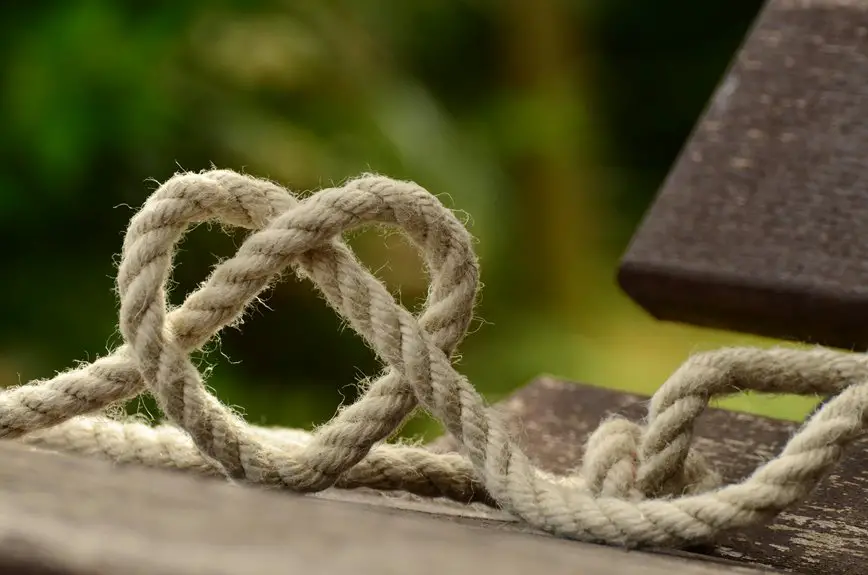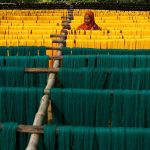Jute fabric typically costs between $3 and $10 per meter, depending on quality, weave density, and origin. Per yard, you can expect prices ranging from $1 to $15, with raw jute being cheaper and processed, finer fabrics costing more. Buying wholesale usually lowers the price, while retail purchases are costlier for smaller amounts. Your choice of supplier and fabric type also affects cost. If you want to understand how to pick the best option for your needs, there’s more to reflect on.
Table of Contents
Key Takeaways
- Jute fabric prices vary from $3 to $10 per meter depending on quality and weave density.
- Per yard, jute fabric ranges between $1 to $15, influenced by grade and region.
- South Asia offers the most affordable jute at $1.50 to $3.00 per yard.
- Wholesale purchases lower the cost to around $1.50 to $2.00 per meter for large quantities.
- Processed jute costs more than raw jute due to added treatments like dyeing and finishing.
Factors Influencing the Price of Jute Fabric
Although jute fabric is generally affordable, several key factors influence its price per meter or yard.
You’ll notice quality plays a big role; finer, softer jute costs more because it requires better processing. The weave density matters too—tighter weaves use more material, pushing the price up.
Origin also affects cost since jute grown in certain regions is prized for superior fiber. Additionally, treatments like dyeing or waterproofing add to the price since they involve extra labor and materials.
Supply and demand impact pricing as well: if demand spikes or harvests fall short, prices rise.
Finally, the fabric’s width can change the cost—wider fabric usually costs more per meter because it uses more fibers.
Understanding these factors helps you make smarter buying choices.
Average Cost Range for Jute Fabric Per Meter
Now that you know what influences the price of jute fabric, let’s look at the typical cost you can expect per meter.
Generally, jute fabric runs between $3 to $10 per meter, depending on quality and weave. Basic, coarse jute suitable for crafts or sacks tends to fall on the lower end, around $3 to $5.
Jute fabric typically costs $3 to $10 per meter, varying by quality and weave type.
If you’re looking for finer, softer jute with tighter weaving for upholstery or fashion, expect to pay closer to $7 to $10 per meter. Specialty or organic jute fabrics can push prices even higher.
Keep in mind, bulk purchases usually bring down the cost per meter. So, when budgeting, consider the fabric’s intended use and quality to find the right balance between price and performance.
Average Cost Range for Jute Fabric Per Yard
When buying jute fabric by the yard, you’ll notice prices vary based on quality and where you shop.
Different regions offer different rates, so it pays to compare locally and online.
Also, don’t forget that buying in bulk often gets you a better deal per yard.
Price Variations by Quality
Since jute fabric comes in various grades, its price per yard can differ greatly.
If you choose a lower-grade jute, expect to pay around $1 to $3 per yard. This fabric tends to have a coarser texture and more imperfections, making it suitable for rougher uses like sacks or packaging.
Mid-range quality jute, costing between $4 and $7 per yard, offers better durability and a more consistent weave, ideal for upholstery or home décor.
High-quality jute, priced from $8 up to $15 or more per yard, features finer fibers and tighter weaves, perfect for fashion items or premium crafts.
Your choice depends on your project’s needs and budget, so consider the quality carefully to get the best value.
Regional Cost Differences
Although jute fabric prices vary by quality, regional factors also play a significant role in cost differences. Depending on where you buy, the price per yard can shift noticeably due to local production, labor costs, and transportation expenses.
For example, jute sourced directly from producing countries tends to be cheaper than imported fabric. Keep these regional influences in mind when budgeting for your project.
Here’s a quick overview of average price ranges by region:
- South Asia (India, Bangladesh): $1.50 – $3.00 per yard
- Southeast Asia (Thailand, Vietnam): $2.00 – $4.00 per yard
- Europe: $4.00 – $7.00 per yard
- North America: $5.00 – $8.00 per yard
Knowing this helps you find the best deal based on your location.
Bulk Purchase Discounts
Prices for jute fabric can vary greatly depending on where you buy, but you can also save by purchasing in bulk. When you buy larger quantities, suppliers often offer discounts that greatly lower the cost per yard.
For example, while a single yard might cost between $5 and $8, buying 50 yards or more could reduce the price to around $3 to $5 per yard. These savings add up quickly, especially if you need fabric for a big project or resale.
Make certain to check with wholesalers or fabric distributors who specialize in bulk orders. Just keep in mind that minimum order requirements can vary, so it’s wise to compare deals before committing.
Bulk buying not only saves money but also guarantees you have enough fabric on hand.
Comparing Prices: Raw Vs Processed Jute Fabric
When you compare raw and processed jute fabric, you’ll notice distinct differences in cost that reflect their production stages.
Raw jute is cheaper since it undergoes minimal treatment, while processed jute involves cleaning, bleaching, dyeing, and finishing, adding to the price.
You’ll find that processed jute offers better texture and durability, justifying the higher cost.
Here’s a quick cost comparison:
- Raw jute: Lower price, rough texture, less uniformity
- Processed jute: Higher price, smoother finish, enhanced durability
- Bulk raw jute: More affordable but limited in application
- Bulk processed jute: Costlier but suitable for premium uses
Understanding these differences helps you pick the right fabric for your budget and project needs.
How Quality Affects Jute Fabric Pricing
When you choose jute fabric, the material grade plays a big role in price differences.
Higher-grade jute with tighter weave density usually costs more but offers better durability.
Understanding these factors helps you get the best value for your budget.
Material Grade Variations
Quality plays an essential role in determining the cost of jute fabric per meter or yard. When you choose jute, you’ll notice that the material grade directly affects pricing. Higher-grade jute fibers are stronger, with fewer impurities, which means they’re more durable and visually appealing.
Lower grades may be rougher and less uniform, reducing their value. Here are key factors influencing material grade variations:
- Fiber length and strength: Longer, stronger fibers cost more.
- Purity: Less contamination or debris increases price.
- Color consistency: Uniform color appeals more and fetches a premium.
- Processing method: Hand-processed jute often has better quality but costs more.
Weave Density Impact
The grade of jute fibers sets the foundation, but the weave density further shapes the fabric’s price.
When the weave is tight and dense, you get a sturdier, more durable fabric that demands a higher price. This kind of weave requires more material and precise craftsmanship, which naturally increases production costs.
On the other hand, a looser weave uses less jute and takes less time to produce, making it more affordable. However, it may not hold up as well under strain or wear.
Regional Price Variations of Jute Fabric
Because jute fabric prices fluctuate greatly across regions, you’ll notice varying costs depending on where you shop. Local demand, production costs, and transportation all play a role in these differences.
For instance, jute is cheaper near major cultivation areas due to lower shipping expenses.
Consider these regional price factors:
- South Asia (Bangladesh, India): Lowest prices, as jute is widely grown and processed here.
- Europe: Higher prices due to import duties and shipping fees.
- North America: Moderately high prices, factoring in import costs and limited local supply.
- Southeast Asia: Prices vary widely depending on local production capacity and demand.
Knowing these variations helps you choose the most cost-effective option for your needs.
Wholesale Vs Retail Prices for Jute Fabric
When you buy jute fabric in bulk, you’ll usually pay less per meter than you would at retail stores. Wholesale prices benefit from economies of scale, making them ideal if you need large quantities. Retail prices, on the other hand, are higher due to packaging, marketing, and convenience.
Here’s a quick comparison:
| Purchase Type | Price per Meter (USD) | Typical Quantity |
|---|---|---|
| Wholesale | $1.50 – $2.00 | 50 meters or more |
| Retail | $3.00 – $5.00 | 1 to 5 meters |
| Small Bulk | $2.00 – $3.00 | 10 to 49 meters |
Choosing wholesale saves you money if you need a lot, while retail suits smaller projects or occasional use.
Impact of Fabric Weave and Thickness on Cost
Although you might focus on quantity and purchase type, fabric weave and thickness play a big role in determining jute’s cost per meter. Tighter weaves generally require more material and time, increasing the price. Thicker jute fabrics, often used for durable applications, also cost more due to higher fiber content.
Consider these factors affecting cost:
- Weave Density: Denser weaves mean more fibers per square inch, raising production time and expenses.
- Fabric Thickness: Thicker fabric demands more raw jute, pushing prices up.
- Texture Complexity: Intricate patterns or specialized weaves can increase labor, impacting cost.
- Weight Per Meter: Heavier fabric weighs more, affecting shipping and material costs.
Where to Buy Affordable Jute Fabric
You can find affordable jute fabric by comparing prices from online retailers, checking out local fabric stores, and exploring deals from wholesale suppliers.
Each option offers different benefits depending on your needs and budget.
Let’s look at how to make the most cost-effective choice.
Online Retailers Comparison
Since shopping for jute fabric online offers convenience and variety, you’ll find several retailers competing to provide the best prices and quality.
To get the most value, compare offerings from multiple sources before buying. Here are some reliable online retailers to take into account:
- Amazon: Wide selection, user reviews, and competitive prices.
- Etsy: Unique, handcrafted options from individual sellers.
- Fabric.com: Specialized fabric retailer with bulk discounts.
- Alibaba: Best for wholesale prices if you need large quantities.
Pay attention to shipping costs and return policies, as they can affect the overall price.
Also, check fabric details like weave, weight, and dye quality to make sure you get what suits your project.
Local Fabric Stores
Shopping online offers great options, but exploring local fabric stores can also help you find affordable jute fabric quickly and in person.
When you visit these stores, you can feel the texture, check the quality, and compare different types before buying. Local shops often carry a variety of jute fabrics in multiple weights and weaves, so you’ll have plenty of choices.
Plus, you might find sales or discounts that aren’t advertised online. Don’t hesitate to ask store employees for recommendations or bulk pricing if you plan to buy larger amounts.
Visiting local stores also saves you shipping costs, making your purchase more economical. Check out craft markets or specialty textile shops near you—they’re great places to discover unique jute fabrics at reasonable prices.
Wholesale Suppliers Deals
Although local stores offer convenience, buying from wholesale suppliers can greatly cut the cost of jute fabric per meter or yard.
When you purchase in bulk, suppliers often provide significant discounts, helping you save more in the long run.
Plus, wholesale sources tend to have a wider variety of jute fabrics, so you can find exactly what you need at a better price.
To find affordable jute fabric, consider these options:
- Online wholesale marketplaces like Alibaba or IndiaMART
- Direct manufacturers who sell bulk jute rolls
- Local wholesale fabric distributors in textile hubs
- Trade shows or fabric expos offering special bulk deals
Tips for Getting the Best Deals on Jute Fabric
Wondering how to score the best deals on jute fabric without compromising quality? Start by comparing prices from multiple suppliers, both online and local.
Don’t hesitate to ask for samples to check the texture and durability before buying in bulk. Buying during off-season or promotional sales can also save you money.
Request samples to test quality, and shop during sales or off-season to maximize savings.
Consider purchasing larger quantities to negotiate better rates, but only if you’re certain about usage. Look for suppliers who offer free shipping or discounts on bulk orders to cut costs further.
Finally, stay updated on market trends and jute availability, as prices fluctuate with demand and harvest cycles.
Frequently Asked Questions
What Are the Common Uses of Jute Fabric?
Think of jute as nature’s sturdy thread weaving through your daily life. You’ll find it in bags, rugs, curtains, and upholstery, giving eco-friendly charm while being strong and breathable for many practical uses.
How Durable Is Jute Fabric Compared to Cotton?
You’ll find jute fabric is quite durable, especially for coarse, heavy-duty uses, but it’s less flexible and softer than cotton. It’s great for bags or rugs, but cotton lasts longer in clothing and daily wear.
Is Jute Fabric Environmentally Friendly?
Like Robin Hood stealing from waste, you’ll find jute fabric’s eco-friendly charm hard to beat. It’s biodegradable, requires less water, and grows quickly, making it a sustainable choice that’s gentle on our planet’s resources.
Can Jute Fabric Be Dyed Easily?
You can dye jute fabric, but it’s a bit tricky since jute absorbs dye unevenly. You’ll want to use fiber-reactive dyes and pre-treat the fabric to get better, brighter, and more consistent colors.
How Should Jute Fabric Be Maintained or Cleaned?
You should clean jute fabric gently by spot cleaning with mild detergent and cold water. Avoid soaking or machine washing it. Let it air dry to prevent shrinking or damage. Regular dusting keeps it fresh.
- Does Chiffon Fabric Stink - July 15, 2025
- Does Chiffon Fabric Affect the Economy - July 15, 2025
- Does Cotton Fabric Have a Nap - July 15, 2025







